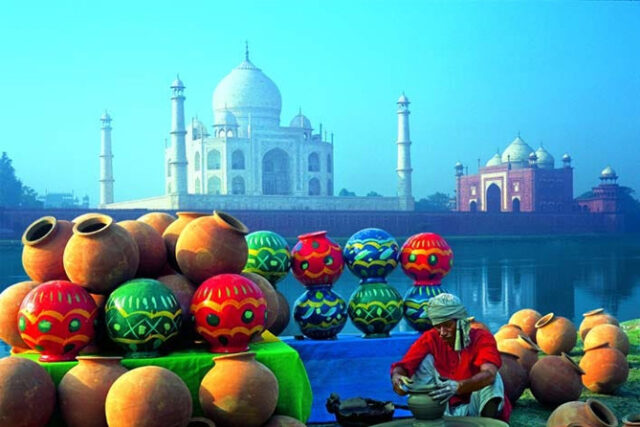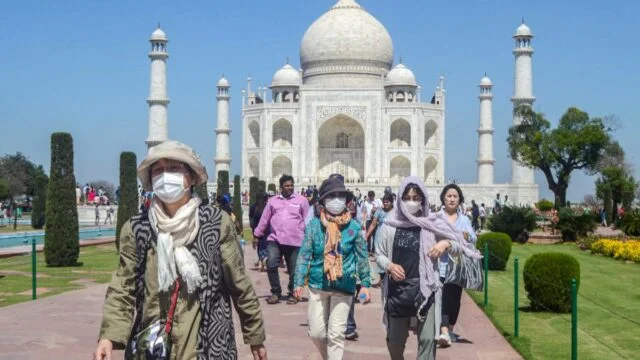Agra, home to the majestic Taj Mahal, is one of India’s most iconic tourist destinations. With millions of visitors each year, the city’s tourism-related businesses have significant potential for growth and prosperity. However, in today’s digital age, having a strong online presence is essential for success. This is where effective website development comes into play. In this blog, we’ll explore how website development can strengthen Agra’s tourism-related businesses and enhance the overall visitor experience.

1. Showcasing Unique Offerings
A well-designed website acts as a digital storefront for tourism-related businesses in Agra. Whether it’s hotels, restaurants, tour operators, or local artisans, having a visually appealing and user-friendly website helps showcase unique offerings. High-quality images, engaging content, and clear descriptions of services can captivate potential visitors and entice them to explore what Agra has to offer.
For instance, a local hotel can highlight its amenities and special packages through an intuitive layout, making it easier for visitors to find information and make reservations. Similarly, tour operators can present various itineraries, including cultural tours, culinary experiences, and heritage walks, appealing to a diverse range of tourists.
2. Enhancing Visibility and Reach
With the growing reliance on the internet for travel planning, a robust website ensures that Agra’s businesses are easily discoverable. Search engine optimization (SEO) techniques can enhance a website’s visibility in search engine results, attracting more visitors. By incorporating relevant keywords and optimizing content, businesses can increase their chances of appearing on the first page of search results when potential tourists search for Agra-related queries.
Moreover, an engaging blog section can further improve SEO while providing valuable information to travelers, establishing businesses as credible sources of information. Topics can range from local attractions and hidden gems to tips for navigating the city, creating an informative platform that attracts and retains visitors.
3. Facilitating Online Bookings and Reservations
In the digital age, convenience is key. Integrating online booking systems into websites allows tourism-related businesses in Agra to streamline their operations and improve customer satisfaction. Whether it’s booking a room, reserving a table at a restaurant, or scheduling a guided tour, an easy-to-use online booking system reduces friction and enhances the customer experience.
By offering online payment options and instant confirmations, businesses can also build trust with potential customers. This seamless process not only increases conversion rates but also allows businesses to manage bookings more effectively, reducing the chances of overbooking or scheduling conflicts.
4. Building Customer Relationships
A well-developed website offers various tools for businesses to engage with their customers before, during, and after their visit. Features such as newsletters, contact forms, and social media integration allow businesses to maintain communication with their clients. By sending out newsletters with updates, promotions, or personalized offers, businesses can foster a sense of connection and encourage repeat visits.
Furthermore, customer reviews and testimonials can be prominently displayed on websites, building credibility and influencing potential visitors’ decisions. Positive feedback acts as powerful social proof, showcasing the quality and reliability of Agra’s tourism-related businesses.
5. Promoting Local Culture and Heritage
Agra’s rich history and cultural heritage are major draws for tourists. Website development allows businesses to tell their unique stories, promoting local culture and heritage effectively. By highlighting local festivals, traditions, and historical significance, tourism-related businesses can create a narrative that resonates with visitors, offering them a deeper understanding of the city.
For example, local artisans can showcase their crafts and the stories behind their products through a dedicated section on their website. This not only enhances the cultural experience for tourists but also supports the local economy and encourages the preservation of traditional crafts.
6. Adapting to Mobile Trends
With the increasing use of smartphones for travel planning, having a mobile-friendly website is crucial. Responsive website design ensures that visitors have a seamless browsing experience, regardless of the device they use. This adaptability is essential for capturing the attention of on-the-go travelers looking for quick information or last-minute bookings.
A mobile-optimized site can significantly enhance user experience, making it easier for potential customers to explore offerings, read reviews, and make reservations, ultimately driving more business.
Conclusion
Website development plays a pivotal role in strengthening Agra’s tourism-related businesses by enhancing visibility, showcasing unique offerings, facilitating online transactions, and promoting local culture. In a competitive market where digital presence can make or break a business, investing in a robust and user-friendly website is essential for success. By embracing digital solutions, Agra’s tourism sector can attract more visitors, boost local businesses, and contribute to the city’s economic growth, all while providing an unforgettable experience for tourists.


No responses yet